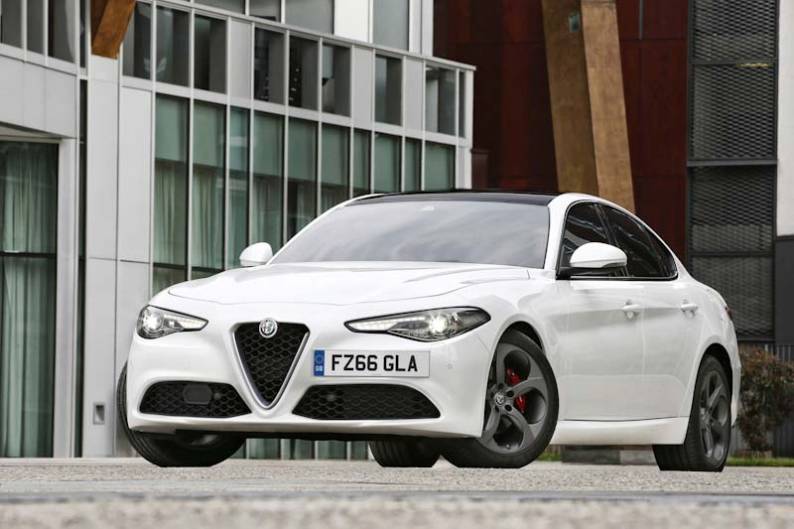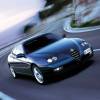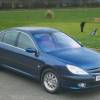
RAC sale – up to 33% off*
• Roadside cover from £5.29 a month†
• We get to most breakdowns in 60 mins or less
• Our patrols fix 4/5 breakdowns on the spot

By Jonathan Crouch
Introduction
Distinctive Italian design makes Alfa Romeo's Giulia stand out in the compact executive saloon segment, but this Latin contender has far more up its tailored sleeve than just good looks. Innovative engines, perfect weight distribution, unique technology and a best-in-class power-to-weight ratio deliver a car worthy of its famous maker. Here, we check out the earlier 2016-2022 versions of this model as a used buy.
Models
4dr Saloon (2.0 petrol, 2.9 V6 petrol / 2.2 diesel)
History
The Alfa Romeo Giulia in this modern-era 'Type 952' form was probably the most important car to be launched in the history of this famous Milanese brand. You'll want to know why. Well at its introduction here in 2016, this premium compact executive sports saloon was the first completely new mainstream Alfa we'd seen since the Giulietta in 2010. And it was the first rear wheel drive contender the marque had sold since the 75 model went out of production back in 1992. That was the last car to be developed by Alfa Romeo before Fiat took control of the company. Which was significant because all the products launched by the brand since were front-driven and, to put it politely, very Fiat-orientated. To some extent, that explained the relative lack of success of the two sports saloons the firm introduced after the 75, the 156 of 1998 and the 159 of 2006.
These stylish contenders had some, but unfortunately not all, of the basic elements really needed for a car of this kind: an ideally weighted chassis, superb handling, emotive looks and crisp, characterful high performance engines. Alfa itself knew this, having originally established these fundamentals in what could be seen as the very first car of this kind to be launched on the market, the original 'Type 105' Giulia model, which sold between 1962 and 1978. In reviving this famous badge, the brand also hoped to revive the unique appeal that once made its products so appealing and different.
Certainly, the prospects with this 'Type 952' model seemed promising. The rear-driven 'Giorgio' platform this model shared with Alfa's Stelvio SUV was all-new, plus there was a raft of new engines including, crucially, an all-aluminium four cylinder diesel unit - the kind of powerplant that the majority of business buyers in the sports saloon segment still wanted back in the 21st century's second decade. Plus, to provide a few halo headlines for the line-up, there was also a 510bhp V6 Biturbo Quadrifoglio super saloon variant, the fastest Alfa ever made.
Following this Giulia's original launch, Alfa put quite a lot of effort into refettling it over the years, starting with the first of the two range updates - in September 2018, which saw the introduction of more efficient Euro 6D engines. The line-up was further revised for the 2020 model year, with upgraded cabin infotainment, level 2 drive assist features and a range of Alfa Connected Services. And an even faster 540hp limited-run GTA version of the Quadrifoglio arrived in February 2020. Before diesel engines were dropped in early 2022. A further update package was announced for the 2023 model year, but it's the earlier 2016-2022-period Giulias we're going to look at here.
What You Get
You might, quite justifiably, feel pretty pleased with yourself when parking one of these amongst the Mercs, BMWs and Audis of your middle management colleagues. Even before you notice the evocative badge on the classic triangular trefoil nose, it's clear that this is a car with a uniquely Italian sense of flair, something further emphasised by the long bonnet, the short overhangs and the muscular haunches. There really is nothing quite like the Giulia in his segment.
And at the wheel? Well you'd hope for old fashioned Alfa charisma with modern functionality and Teutonic quality and this Giulia makes a good stab at achieving exactly that. True, there are a few issues with fit and finish, especially with some elements of the switchgear - and the Giulia can't match its German rivals in terms of media connectivity, though the 8.8-inch centre dash infotainment screen works effectively. There's so much else that's seductive about this cabin though; the deeply-cowled dials, a grippy little three-spoke wheel, splashes of aluminium and huge, evocative gear change paddles behind the steering wheel (fitted to plusher models) that look as if they were originally designed for a Ferrari - and probably were. Get a car whose original owner added a bit of embellishment - say the luxury 'Lusso Pack' with stitched 'Pieno Fiore' leather sumptuous 'Silverwood' trim - and the interior can look absolutely gorgeous.
When it's time to take a seat in the rear, taller folk might find access hindered a little by the swept-back roofline. Still, the rear door opens decently wide and once inside, you'll find that there's a decent amount of back seat space by class standards, with plenty of space to push forward your feet beneath the front seats. The boot opens to reveal a 480-litre capacity that, surely not co-incidentally, is the exact equal of a BMW 3 Series or a Mercedes C-Class from this era.
What You Pay
Prices for this Giulia start at around £13,350 (around £15,850 retail) for a 2.0-litre petrol model on a '16-plate. A later 2.0-litre petrol model, say a late '22-plate 2.0 280 Veloce, requires £35,000 (£38,250 retail). Diesels start from around £13,600 (around £16,100 retail), which gets you an early '16-plate 2.2 JTDM-2 Super model. One of the last 2.2 JTDM-2 160 Super models on a late '21-plate values at around £21,550 (around £24,000 retail). The rare petrol 2.9 V6 BiTurbo Quadrifoglio super saloon values from around £31,000 (around £36,000 retail) on an early '16-plate, with a late '22-plate model valuing at around £53,400 (around £61,000 retail). All quoted values are sourced through industry experts cap hpi. Click here for a free valuation.
What to Look For
Though quite a few owners in our survey seemed happy, there are certainly things that you'll need to look for. We've come across a number of problems with the suspension and axles which include issues with the drive mode selector causing the suspension to lock up. Some owners have reported that the front suspension clunks over small bumps. We've also come across quite a few electrical issues. A number of owners have had battery failures, which in some cases are prefaced by assistance module failures such as the start stop system ceasing to work. Some owners have had issues with engine electronics, resulting in in all kinds of issues ranging from the engine check light coming on to complete limp mode activation. To be fair, the more severe issues mainly affected very early 2016 models.
Some owners have reported that the infotainment screen and the central dashboard screen have become dark and unresponsive: this requires a software update. We also heard of problems with the E-brake system getting stuck, which needs to be released in the brake service mode on the infotainment screen. Look out for dashboard warning lights that glow without an actual malfunction. And there are reports of 'service electronic throttle control' warning messages on the dashboard, which need to be resolved by a software update. Overall, you'd we wise to insist on a fully stamped-up service history.
Replacement Parts
(approx based on a 2020 Giulia 2.0 280hp - Ex Vat) An air filter costs in the £24 bracket. An oil filter costs in the £8 bracket. Front brake pads sit in the £72-£92 bracket for a set; for a rear set, it's in the £50 bracket. Front brake discs sit in the £83 bracket; for rears, think in the £122-£139 bracket. A tail lamp is in the £217-£265 bracket. And a pollen filter is in the £5-£22 bracket. A wiper blade is in the £4-£14 bracket. A fuel filter is around £18.
On the Road
If the look of this Alfa didn't make you want to buy it, the driving experience it offers might well do. Of course, the Giulia is saddled with quite a weight of expectation here, tasked with embodying all of this famous Italian brand's heritage and sporting prowess. That it can deliver on this is evident in the first few miles you spend at the wheel. The steering's quick and very responsive, the brakes are brilliant and the stiff, sophisticated rear-driven chassis delivers a low centre of gravity, a perfect 50-50 front-to-rear weight balance and structural rigidity that keeps body roll well in check. Active suspension was optional from new, as was a limited slip differential' to help get the power down through bends. All Giulias though, got Alfa's 'DNA' drive modes system, so that you can tweak the throttle, the steering and gearchange timings to suit the mood you're in.
All the engines on offer were freshly developed for this car and almost all Giulia buyers will choose between two very different units. The 2.0-litre petrol turbo powerplant is one way you could go, offered with either 200 or 280bhp. Or there's the 2.2-litre diesel, available in either 150 or 180bhp states of tune. In both cases, you can expect competitive efficiency figures - 67.3mpg on the combined cycle and 109g/km of CO2 (NEDC figures). For our market, all the engines had to be mated to an 8-speed auto gearbox you can activate with deliciously emotive Ferrari-style paddleshifters. And, talking of Ferrari influence, we should also mention the Maranello-engineered flagship variant, the storming 2.9-litre V6 Biturbo 510bhp Quadrifoglio super saloon, the fastest Alfa ever made.
Overall
The Giulia was never going to cure all of Alfa's problems but it did set the brand back on the road to a more profitable future. Is this the perfected, finished article - the kind of car you'd get if you went for an A4, a C-Class or a 3 Series from this period in this segment? Well no. It's not quite as quiet or as well finished inside as those cars, issues that might drive some potential buyers back into the arms of those German brands with their understated air of superiority.
Others might rightly conclude that they never expected an Alfa to be perfect and that this one gets closer to that mark than any other model in the company's history. These people might also tell you that the whole reason they're considering a Giulia in the first place is precisely because they don't like the rather condescending 'we know what's best for you' perfection that's become such a mark of Teutonic engineering. If you share that view, we think you'll find this riveting, idiosyncratic and striking Italian contender to be a real breath of fresh air in a segment that's become rather set in its ways. It's not only an Alfa you could love, it's also one you could justify. Which is about as much as anyone can ask for.







